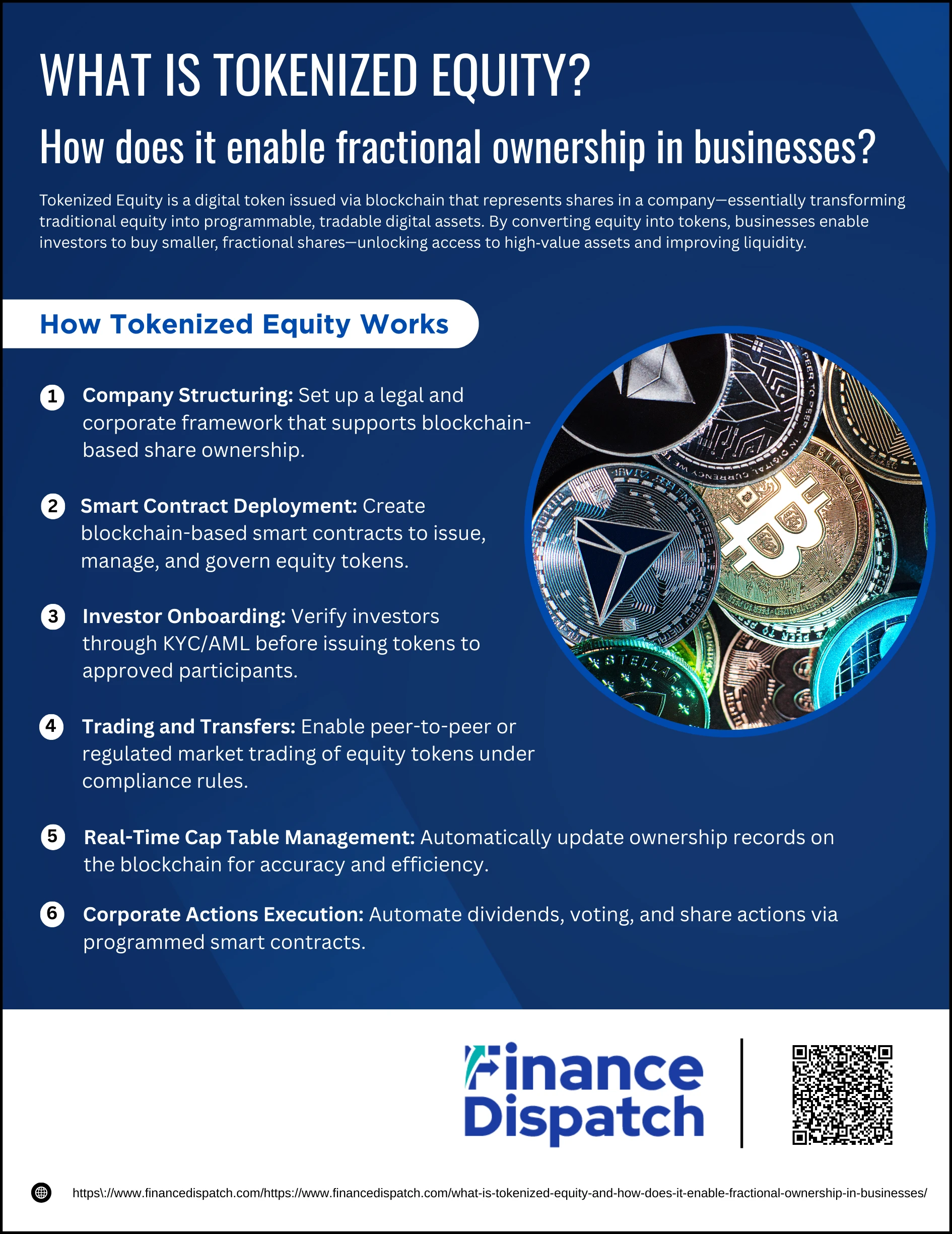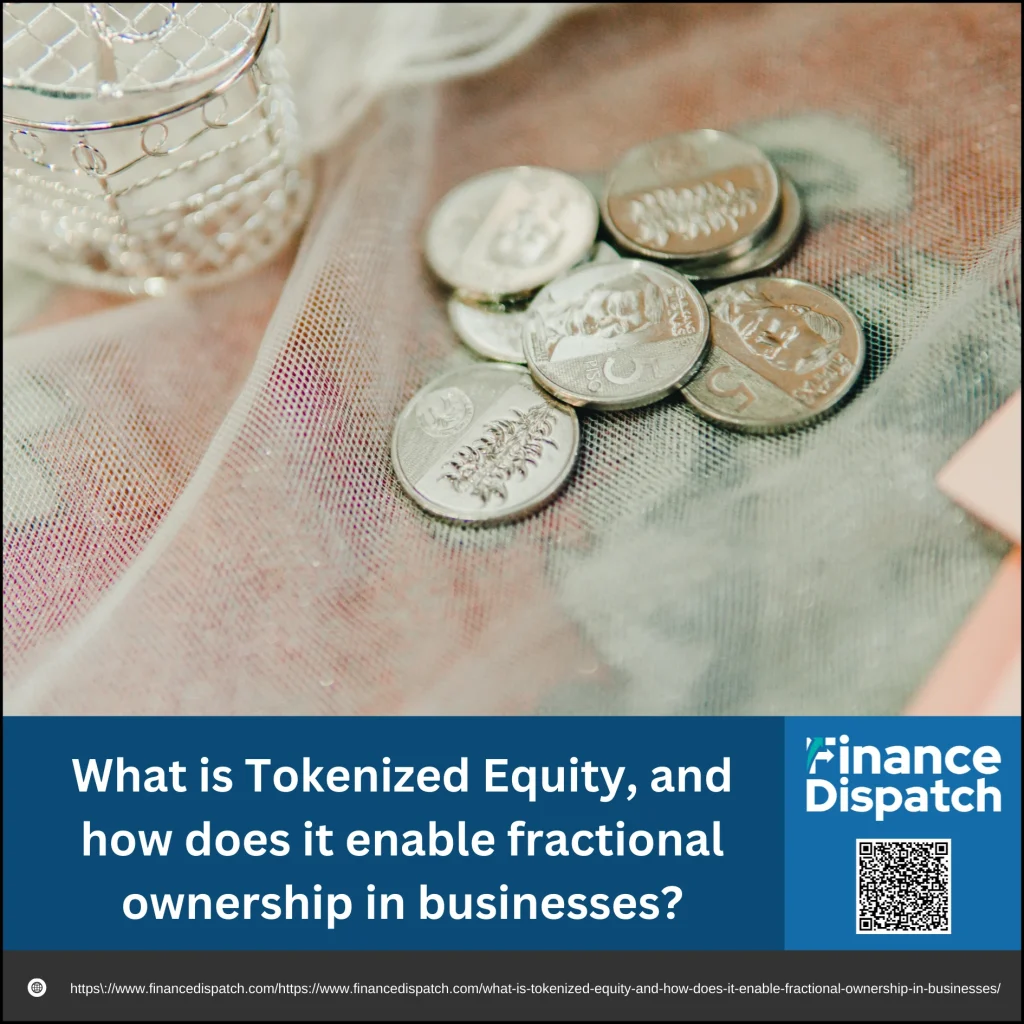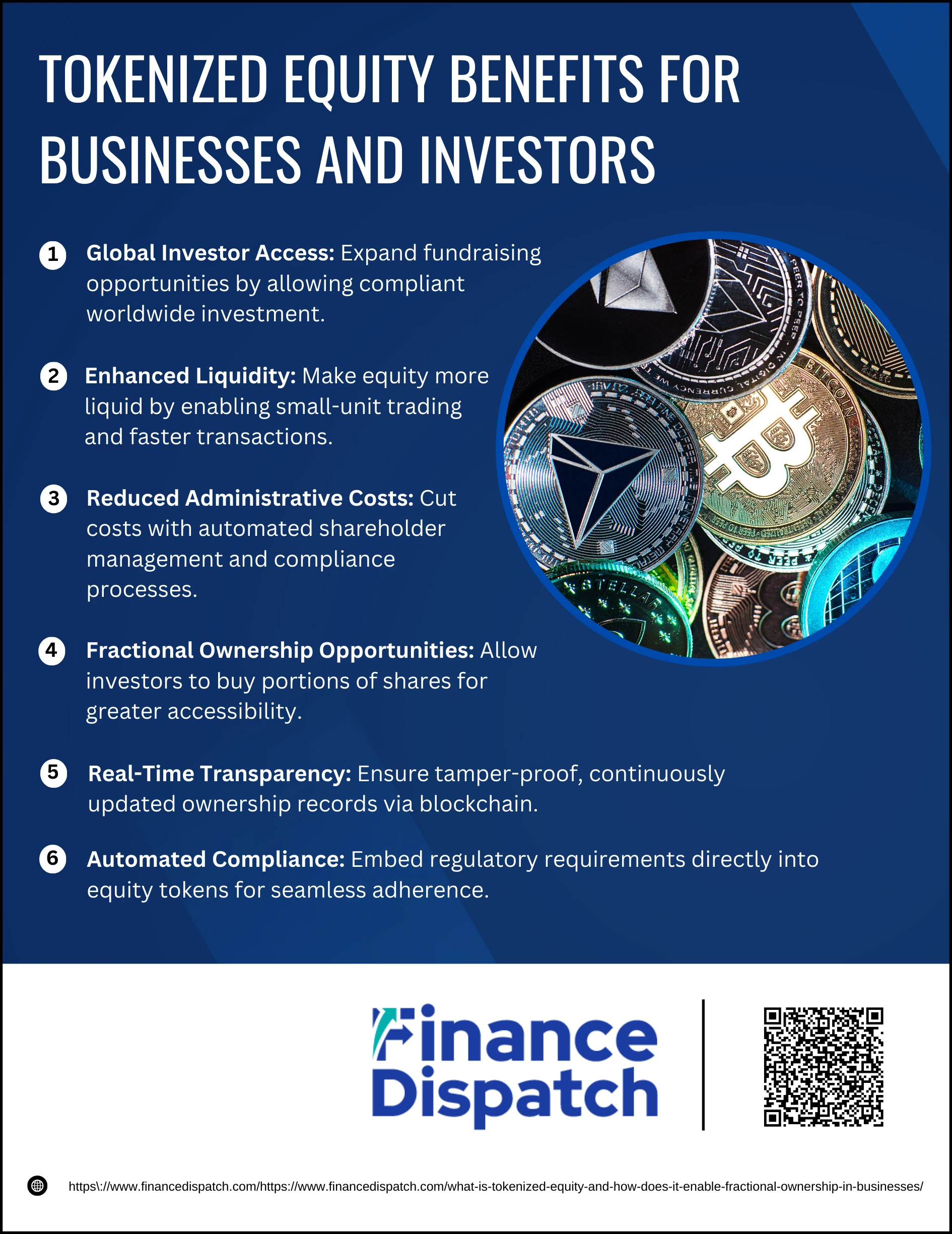In today’s rapidly evolving financial landscape, tokenized equity is emerging as a transformative way for businesses to raise capital and for investors to participate in ownership. By converting traditional company shares into blockchain-based digital tokens, organizations can make ownership more accessible, transparent, and efficient. This digital approach not only streamlines processes like shareholder management and compliance but also unlocks the possibility of fractional ownership—allowing investors to buy and sell smaller portions of equity that were once out of reach. The result is a more inclusive investment environment where opportunities are no longer limited by geography, high entry costs, or lengthy administrative procedures.
What is Tokenized Equity?
Tokenized equity is the digital representation of a company’s shares on a blockchain, where each share is issued as a cryptographic token that can be securely stored, transferred, and traded. Like traditional shares, these tokens grant ownership rights—such as voting power, dividends, or profit-sharing—but they benefit from the transparency, automation, and programmability of blockchain technology. Instead of relying on paper records or centralized databases, ownership is recorded and updated in real time on a distributed ledger, making the process more efficient and less prone to errors. This modern approach not only streamlines equity management but also opens the door to innovative investment structures, including fractional ownership and 24/7 global trading.
 How Tokenized Equity Works
How Tokenized Equity Works
Tokenized equity moves company shares from traditional paper or centralized records onto a blockchain, where each share is represented as a secure, programmable digital token. This process not only digitizes ownership but also enables faster transactions, automated compliance, and greater investment accessibility through fractional ownership.
1. Company Structuring
Before shares can be tokenized, the company must establish a legal structure that supports blockchain-based ownership. This may involve choosing a jurisdiction that recognizes digital securities, updating corporate bylaws, and ensuring shareholder agreements align with token-based transfers. In some cases, companies might need to adopt a digital share registry or work with a licensed tokenization platform to remain compliant.
2. Smart Contract Deployment
Once the legal foundation is set, the company deploys a smart contract—a self-executing program stored on the blockchain—that defines how tokens are issued, transferred, and managed. Each token represents a specific share and can include programmed rules such as voting rights, dividend distribution, and transfer restrictions. Smart contracts remove the need for intermediaries, reduce errors, and ensure transactions follow predefined rules automatically.
3. Investor Onboarding
Compliance is critical when issuing tokenized equity. Investors must complete identity verification through Know Your Customer (KYC) and Anti-Money Laundering (AML) checks before receiving tokens. This ensures only authorized participants can hold the company’s equity and helps meet regulatory standards in different jurisdictions. Approved investors then receive their tokens directly into a blockchain wallet.
4. Trading and Transfers
Tokenized shares can be traded directly between investors or listed on approved secondary markets that support digital securities. Transactions are peer-to-peer, recorded on the blockchain, and governed by the smart contract’s compliance rules—such as limiting transfers to whitelisted participants or enforcing lock-up periods. This creates a more efficient, borderless trading environment compared to traditional stock exchanges.
5. Real-Time Cap Table Management
A company’s cap table—the record of who owns what—updates automatically whenever tokens are transferred. This eliminates the manual reconciliation process, reduces administrative costs, and ensures founders, legal teams, and investors always have a clear, up-to-date view of equity distribution.
6. Corporate Actions Execution
Beyond simple ownership tracking, tokenized equity allows companies to automate key corporate actions. For example, dividends can be distributed instantly to token holders based on their percentage ownership, stock splits can be executed without paperwork, and shareholder voting can be conducted securely online with instant tallying. All these actions are enforced by the underlying smart contract, ensuring accuracy and transparency.
The Role of Fractional Ownership
Fractional ownership is one of the most powerful advantages of tokenized equity. By dividing company shares into smaller digital units, tokenization allows investors to purchase only a fraction of a share instead of buying whole shares. This greatly lowers the entry barrier, making it possible for smaller investors to participate in opportunities that were once reserved for high-net-worth individuals or institutions. It also increases market liquidity, as more participants can trade smaller amounts, and enables global access to investment without the traditional geographic and financial limitations.
| Feature | Traditional Equity | Tokenized Equity (Fractional Ownership) |
| Minimum Investment | Often high, restricting small investors | Very low, enabling participation from a wider audience |
| Liquidity | Limited, especially in private markets | Higher, due to smaller, tradeable units |
| Market Access | Mostly local or restricted to certain investors | Global, open to anyone meeting compliance requirements |
| Transaction Speed | Days to settle | Near-instant settlement via blockchain |
| Ownership Flexibility | Entire shares only | Fractions of shares possible |
| Administrative Effort | Manual recordkeeping | Automated through smart contracts |
Tokenized Equity Benefits for Businesses and Investors
Tokenized equity merges the advantages of traditional shareholding with the efficiency, transparency, and global reach of blockchain technology. For businesses, it creates new pathways to raise capital, reduce operational burdens, and connect with a wider pool of investors. For investors, it opens doors to assets previously out of reach, improves liquidity, and offers greater control over investment decisions.
1. Global Investor Access
Tokenization removes the traditional geographic restrictions on fundraising. A company in one country can issue equity tokens to investors worldwide, provided compliance requirements are met. This dramatically increases the potential investor base, giving businesses more opportunities to raise funds and allowing investors from any location to participate in ventures they believe in.
2. Enhanced Liquidity
In traditional private equity markets, selling shares can take months or even years. With tokenized equity, shares can be broken into smaller, more affordable units and traded on regulated secondary markets or peer-to-peer platforms. This creates a more liquid environment where investors can exit investments sooner, and companies can attract investors who value flexibility.
3. Reduced Administrative Costs
Smart contracts handle many administrative functions that traditionally require manual processing, such as updating shareholder registers, processing dividend payments, and tallying votes. By eliminating intermediaries and reducing paperwork, companies save on legal, accounting, and compliance costs, while investors benefit from faster, more efficient transactions.
4. Fractional Ownership Opportunities
Instead of requiring large capital commitments, tokenized equity allows investors to buy just a fraction of a share. This democratizes access to high-value companies, enabling smaller investors to diversify across multiple assets and reduce risk. For businesses, fractional ownership increases the likelihood of attracting a broad range of investors.
5. Real-Time Transparency
Every token transaction is recorded on the blockchain, providing both companies and investors with a continuously updated, tamper-proof view of ownership structures. This transparency builds trust, simplifies due diligence, and reduces disputes over shareholding records.
6. Automated Compliance
Regulatory requirements—such as restricting transfers to approved investors, enforcing lock-up periods, and ensuring only verified participants hold shares—can be embedded directly into the equity token’s smart contract. This automation minimizes the risk of non-compliance and streamlines legal oversight, benefiting both issuers and investors.
Real-World Examples of Tokenized Equity
Tokenized equity is no longer just a theoretical concept—it’s being actively implemented by companies around the world to streamline fundraising, enhance liquidity, and expand investor access. These real-world examples show how businesses across different industries and regions are leveraging blockchain technology to modernize equity ownership and create innovative investment opportunities.
1. Aktionariat (Switzerland) – Enables Swiss companies to tokenize their shares directly on Ethereum, sell them through their own websites, and manage shareholder registers automatically.
2. ONINO (Germany) – Specializes in tokenizing equity for property portfolios, allowing retail investors to buy fractional shares of real estate assets.
3. INX (USA) – A regulated platform that issues and trades security tokens, including tokenized equity for both private and public companies.
4. tZERO (USA) – Provides a blockchain-based alternative trading system for security tokens, offering compliant secondary market trading for tokenized shares.
5. Quadrant Biosciences Inc. (USA) – Tokenized 17% of its equity to raise over $13 million, using tokens to represent ownership and handle corporate actions like voting and dividends.
6. Securitize (Global) – Offers end-to-end tokenization services, from equity issuance to compliant trading, serving startups, investment funds, and enterprises.
Regulatory and Legal Considerations in Tokenized Equity
While tokenized equity offers efficiency, accessibility, and innovation, it operates within a complex regulatory landscape that varies across jurisdictions. Because equity tokens are generally classified as securities, issuers must comply with relevant laws covering investor protection, disclosure, and trading. Failing to meet these requirements can result in legal penalties, invalidated offerings, or reputational damage. Companies looking to tokenize their shares must navigate these rules carefully to ensure both compliance and investor trust.
1. Securities Classification – Most jurisdictions treat equity tokens as securities, meaning they are subject to securities registration, exemptions, and disclosure rules.
2. Jurisdictional Variations – Regulatory requirements differ widely between countries, making cross-border offerings more complex.
3. KYC/AML Compliance – Issuers must verify investor identities and prevent illicit activities through Know Your Customer (KYC) and Anti-Money Laundering (AML) procedures.
4. Transfer Restrictions – Smart contracts may need to enforce limitations on who can hold or trade tokens, based on regulatory approvals or investor eligibility.
5. Prospectus and Disclosure Obligations – Some offerings require detailed prospectuses or information statements to ensure transparency for potential investors.
6. Private Company Share Transfer Rules – Many private companies have restrictions in their governing documents that must be amended before tokenization.
7. Regulatory Sandboxes – Certain jurisdictions offer controlled environments for testing tokenized equity solutions under temporary regulatory relief.
8. Custody and Safekeeping – Tokens must be stored securely, often requiring licensed custodians to comply with investor protection standards.
Potential Challenges and Risks of Tokenized Equity
While tokenized equity brings innovation and efficiency to capital markets, it also introduces a set of challenges and risks that businesses and investors must address. These risks range from evolving regulatory requirements to technological vulnerabilities, and they can significantly impact the adoption and long-term success of tokenized equity. Understanding these potential pitfalls is essential for making informed decisions and implementing safeguards that protect both issuers and investors.
- Regulatory Uncertainty – Laws governing tokenized equity are still developing, creating ambiguity that can delay projects or lead to compliance breaches.
- Market Immaturity – Secondary markets for equity tokens are limited, which can affect liquidity and trading opportunities.
- Smart Contract Vulnerabilities – Coding errors or security flaws in smart contracts could be exploited, leading to financial losses.
- Cybersecurity Threats – Wallets, platforms, and exchanges holding equity tokens may be targeted by hackers.
- Custody and Key Management Risks – Losing private keys can result in permanent loss of ownership without recovery options.
- Investor Education Gaps – Many investors are unfamiliar with how tokenized equity works, increasing the risk of poor decision-making.
- Integration with Legacy Systems – Coordinating blockchain-based tokens with traditional corporate and financial systems can be complex.
- Potential for Market Manipulation – Like other securities, equity tokens could be subject to insider trading or manipulation without adequate monitoring.
The Future of Tokenized Equity
The future of tokenized equity points toward a more open, efficient, and globally connected investment landscape. As blockchain adoption grows and regulatory frameworks mature, more companies—ranging from startups to large enterprises—are expected to embrace digital share issuance. This shift could lead to fully on-chain corporate governance, seamless integration with regulated secondary markets, and real-time cross-border fundraising. Fractional ownership will likely become a standard feature, democratizing access to high-value assets and expanding participation in private markets. While challenges around regulation, interoperability, and investor protection remain, ongoing collaboration between industry players and regulators is set to unlock the full potential of tokenized equity, transforming how businesses raise capital and how investors engage with opportunities worldwide.
Conclusion
Tokenized equity is redefining how ownership in businesses is issued, managed, and traded by merging the trust and rights of traditional shares with the efficiency, transparency, and accessibility of blockchain technology. By enabling fractional ownership, it lowers entry barriers for investors while giving companies access to a global pool of capital and streamlined governance tools. Although regulatory complexity, technological risks, and market immaturity still pose challenges, the rapid pace of innovation and growing institutional interest suggest that tokenized equity will play an increasingly central role in the future of capital markets. For both businesses and investors, it represents not just a technological upgrade, but a fundamental shift toward more inclusive and efficient equity markets.




